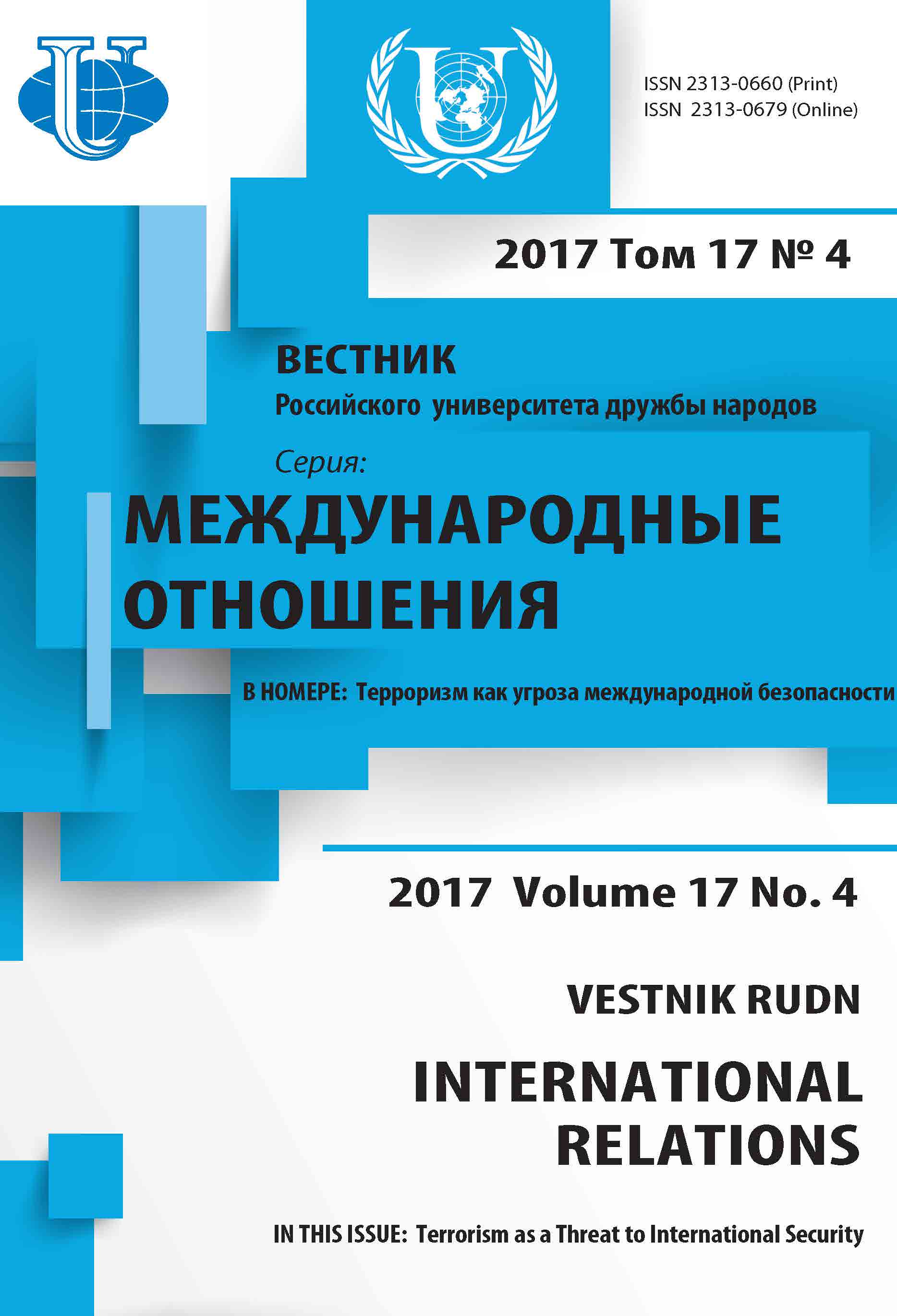ISRAEL’S COOPERATION WITH EAST AFRICAN STATES IN SECURITY AND DEVELOPMENT DOMAINS: CASE OF KENYA
- Authors: Khlebnikova LR1
-
Affiliations:
- Moscow State University in the name of M.V. Lomonosov
- Issue: Vol 17, No 4 (2017): Terrorism as a threat to international security
- Pages: 793-806
- Section: BILATERIAL RELATIONS
- URL: https://journals.rudn.ru/international-relations/article/view/17537
- DOI: https://doi.org/10.22363/2313-0660-2017-17-4-793-806
Cite item
Full Text
Abstract
In February 2016, the Israeli Prime Minister Benyamin Netanyahu declared Israel’s come-back to Africa and Africa’s comeback to Israel. He stressed that the Jewish State is ready to help African countries both in security and development domains. Netanyahu sees these domains, fighting the forces of terror and seizing the opportunities of tomorrow, as interrelated. Due to the recent Israel’s traditional partners’ grievances of Netanyahu’s unwillingness to make compromises on the Palestinian policy, Israeli government is looking toward extending the sphere of influence, adding new partners from Africa, Latin America and Asia. This paper examines the Israeli-Kenyan cooperation as an example of a successful partnership between the Middle Eastern country and the East Africa - its priority region. Special attention is paid to Israel’s military and non-military assistance to Kenya. For strengthening its national security, the Kenyan govern-ment is seeking to gain an access to Israeli military know-how and a vast Israeli counterterrorism expe-rience. Extending military cooperation with Israel, Kenya is also open to Israeli development innovations, especially in the field of agriculture and medicine. The Jewish state is trying to get some economic and trade preferences from Kenya, a diplomatic loyalty in the United Nations, and, finally, a support in de-terring Iran’s African ambitions. The aim of the study is an analysis of the contemporary Israeli-Kenyan cooperation in security and development domains. It was examined official documents of Israeli Foreign Ministry, Knesset and the Kenyan Parliament. The author concludes that to maintain a positive course, Israel and Kenya should con-tinue to deepen their cooperation demonstrating mutual respect for each other's national interests.
Keywords
About the authors
L R Khlebnikova
Moscow State University in the name of M.V. Lomonosov
Author for correspondence.
Email: lkhlebnikova@fmp.msu.ru
Khlebnikova Luiza Romanovna - PhD in History, Research Fellow of the School of World Politics, Lomonosov Moscow State University
References
- Amer, R., Swain, A. & Ojendal, J. (2012). The Security-Development Nexus: Peace, Conflict and Development. New York: Anthem Press.
- Anderson, D.M. & Mcknight, J. (2014). Kenya At War: Al-Shabaab and Its Enemies in Eastern Africa. African Affairs, 114/454, 1—27.
- Back, I. (2013). Al-Shabab's Attack at Westgate Mall: Somalia and Regional Instability. Tel Aviv Notes, 7 (19). URL: http://dayan.org/content/tel-aviv-notes-al-shababs-attack-westgate-mallsomalia-and-regional-instability (accessed: 12.06.2017).
- Birkett, D.J. (2013). The Legality of the 2011 Kenyan Invasion of Somalia and its Implications for the Jus Ad Bellum. Journal of Conflict and Security Law, 18 (3), 427—451.
- Butime, H. (2014), Shifts in Israel-Africa Relations. Strategic Assessment, 17 (3). URL: http://www.inss.org.il/uploadImages/systemFiles/adkan17_3ENG%20(3)_Butime.pdf (accessed: 12.06.2017).
- Carol, S. (2012). From Jerusalem to the Lion of Judah and Beyond. Israel’s Foreign Policy in East Africa. Bloomington: IUniverse.
- Kokoshin, A.A. & Bartenev, V.I. (2016). Security-development nexus in strategic planning in the Russian Federation: From goal-setting to forecasting. Studies on Russian Economic Development, 27 (1), 5—12.
- Kostenko, Y.I. (2016). “New Periphery” As a Factor for Strengthening the Positions of Israel in the Middle East. MGIMO Review of International Relations, 2 (47), 134—144. (In Russ.).
- Mogire, E. (2008). Balancing Between Israel and the Arabs: An Analysis of Kenya’s Middle East Relations. The Round Table: The Commonwealth Journal of International Affairs, 97 (397), 561—574.
- Oluch, M.L. (2009). Kenya’s Foreign Policy towards Israel, 1963—2002. Contradiction between Rhetoric and Practice. Master’s Degree thesis. University of Nairobi. College of Humanities and Social Sciences. Department of Political Science and Public Administration. URL: https://www.uonbi.ac.ke/leonard/files/maumo_thesis.pdf (accessed: 12.06.2017).
- Otenyo, E. (2014). New Terrorism Toward an explanation of cases in Kenya. African Study Review, 13(3), 75—84.
- Otiso, K.F. (2009). Kenya in the Crosshairs of Global Terrorism: Fighting Terrorism at the Periphery. Kenya Studies Review, 1 (1), 107—132.
- Ryzhov, I.V. (2009). The African Dimension of The Israeli Foreign Policy. Vestnik of Lobachevsky University of Nizhni Novgorod, 1, 169—173. (In Russ.).
- Shay, S. (2014). Kenya, Israel and the War against Al-Shabaab. IDC Herzliya, International Institute for Counter-Terrorism, 1—6. URL: https://www.ict.org.il/UserFiles/Shaul%20Shay%20- %20June%202014.pdf (accessed: 12.06.2017).
- Wezeman, S.T. (2011). Israeli Arms Transfers to Sub-Saharan Africa. SIPRI Background Paper.
- Wezeman, P.D., Wezeman, S.T. & Béraud-Sudreau, L. (2011). Arms Flows to Sub-Saharan Africa. SIPRI. Policy Paper.











